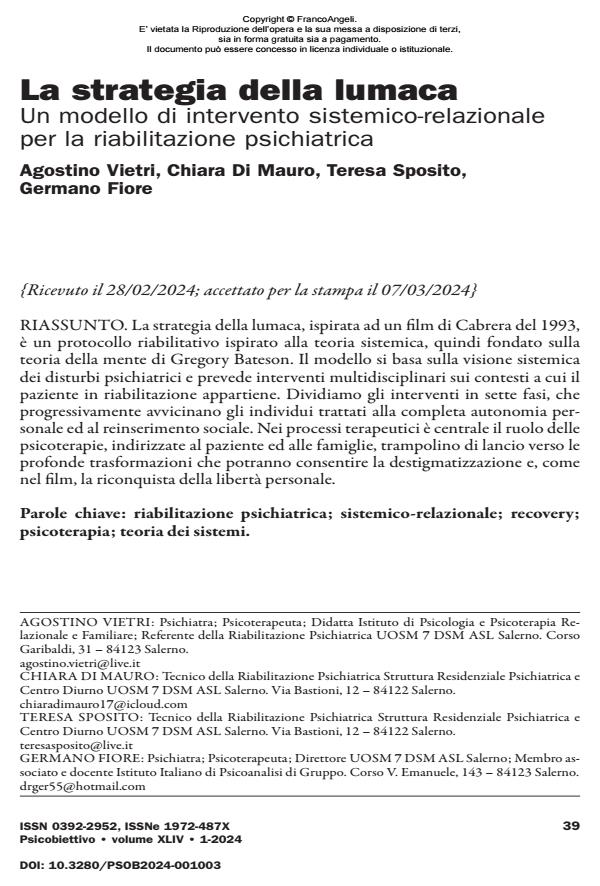La strategia della lumaca Un modello di intervento sistemico-relazionale per la riabilitazione psichiatrica
Titolo Rivista PSICOBIETTIVO
Autori/Curatori Agostino Vietri, Chiara Di Mauro, Teresa Sposito, Germano Fiore
Anno di pubblicazione 2024 Fascicolo 2024/1
Lingua Italiano Numero pagine 15 P. 39-53 Dimensione file 155 KB
DOI 10.3280/PSOB2024-001003
Il DOI è il codice a barre della proprietà intellettuale: per saperne di più
clicca qui
Qui sotto puoi vedere in anteprima la prima pagina di questo articolo.
Se questo articolo ti interessa, lo puoi acquistare (e scaricare in formato pdf) seguendo le facili indicazioni per acquistare il download credit. Acquista Download Credits per scaricare questo Articolo in formato PDF

FrancoAngeli è membro della Publishers International Linking Association, Inc (PILA)associazione indipendente e non profit per facilitare (attraverso i servizi tecnologici implementati da CrossRef.org) l’accesso degli studiosi ai contenuti digitali nelle pubblicazioni professionali e scientifiche
La strategia della lumaca, ispirata ad un film di Cabrera del 1993, è un protocollo riabilitativo ispirato alla teoria sistemica, quindi fondato sulla teoria della mente di Gregory Bateson. Il modello si basa sulla visione sistemica dei disturbi psichiatrici e prevede interventi multidisciplinari sui contesti a cui il paziente in riabilitazione appartiene. Dividiamo gli interventi in sette fasi, che progressivamente avvicinano gli individui trattati alla completa autonomia personale ed al reinserimento sociale. Nei processi terapeutici è centrale il ruolo delle psicoterapie, indirizzate al paziente ed alle famiglie, trampolino di lancio verso le profonde trasformazioni che potranno consentire la destigmatizzazione e, come nel film, la riconquista della libertà personale.
Parole chiave:riabilitazione psichiatrica; sistemico-relazionale; recovery; psicoterapia; teoria dei sistemi.
Agostino Vietri, Chiara Di Mauro, Teresa Sposito, Germano Fiore, La strategia della lumaca Un modello di intervento sistemico-relazionale per la riabilitazione psichiatrica in "PSICOBIETTIVO" 1/2024, pp 39-53, DOI: 10.3280/PSOB2024-001003